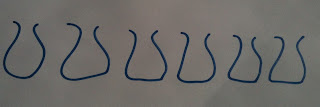Ratio – its in the bag
The
problem
Ratio
can be a difficult concept to understand. Like
fractions you can teach it year after year, think you’ve succeeded but year
after year it has to be retaught. The idea has not sunk in, the long term memory
has not been troubled, it seems as if you are presenting the pupils with a
totally new subject. What is to be done? How can we make our teaching more
efficient, reduce the frustration felt by our kids and us? This is how to teach
finding the ratio of a quantity.
The
solution
Using this method I have had a great
success, although we as teachers nothing is ever 100%, that’s the problem with
teaching humans! First I explain that the head teacher (principal for my
readers in the States) has given me £120 for the class as a reward for
outstanding progress in Mathematics. I tell them the money is in easy to carry bags;
in fact there are 6 bags in all. At this point I draw the 6 bags on the board.
The question is now posed ‘How much is in
each bag?’ Back comes the reply £20. I
fill in £20 in each bag, this is a vital step.
This step is a huge reminder to the kids
and really helps them to find an answer to the question posed, I am always
amazed that even some very bright pupils persist with this method long after
they have progressed beyond this level of Mathematics so it must have a lot of
value.
I now drop the bombshell on the class, I am
going to give them one bag, and I’ll keep the other five. On the drawing I put
in the colon. As you can imagine this is not always greeted with total
approval.
At no point have I mentioned ratio. I now
introduce the word and write on the board the numbers
1:5
You have now laid the groundwork for
explaining ratio. Introduce the word ratio and say when you share out any
quantity the colon is used to show who gets what. I always emphasize that ratio
is really sharing. I do several other examples on the board, always drawing the
bags, always writing the amounts in each bag. I then give the pupils an
exercise on ratio, encouraging them to do the drawing of bags putting the
amount in each bag and hence finding the answer.







